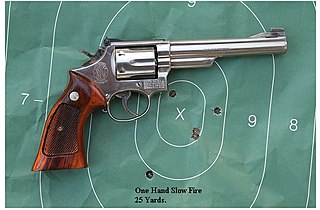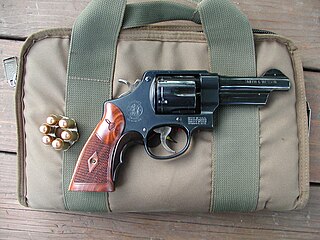
A revolver is a repeating handgun that has at least one barrel and uses a revolving cylinder containing multiple chambers for firing. Because most revolver models hold up to six cartridges, before needing to be reloaded, revolvers are commonly called six shooters or sixguns. Due to their rotating cylinder mechanism, they may also be called wheel guns.

The Smith & Wesson Model 1006 is a recoil operated double-action/single-action semi-automatic handgun chambered in the 10mm Auto cartridge manufactured by Smith & Wesson.

The Smith & Wesson Model 19 is a revolver produced by Smith & Wesson that was introduced in 1957 on its K-frame. The Model 19 is chambered for .357 Magnum. The K-frame is somewhat smaller and lighter than the original N-frame .357, usually known as the Smith & Wesson Model 27. A stainless steel variant of the Model 19, the Smith & Wesson Model 66, was introduced in 1971.

The Smith & Wesson Model 686 is a six- or seven-shot double-action revolver manufactured by Smith & Wesson and chambered for the .357 Magnum cartridge; it will also chamber and fire .38 Special cartridges. Smith & Wesson introduced the Model 686 in 1981. It is the stainless steel version of the Model 586, which featured a blued steel finish. They are available ported and unported with a choice of 6- or 7-round cylinders.

In American English, a pocket pistol is any small, pocket-sized semi-automatic pistol, and is suitable for concealed carry in a pocket or a similar small space.

The Smith & Wesson Model 15, initially the Smith & Wesson K-38 Combat Masterpiece, is a six-shot double-action revolver with adjustable open sights produced by Smith & Wesson on the medium-size "K" frame. It is chambered for the .38 Special cartridge and is fitted with a 4-inch (100 mm) barrel, though additional barrel options have been offered at various times during its production. It is essentially a shorter barrel version of the Smith & Wesson Model 14 and an adjustable-sight version of the seminal Smith & Wesson Model 10 with target shooting features.

The Smith & Wesson K-22 Target Masterpiece Revolver is a six-shot, double-action revolver with adjustable open sights, built on the medium-size "K" frame. When introduced, it was intended for bullseye target shooting competition of the type then most common on the United States, which is today called NRA Precision Pistol, specifically in the "smallbore" or "22" category. It is chambered for the .22 Long Rifle cartridge. It is one of three similar models that Smith & Wesson offered, the other two being intended for the "centerfire" category, the K-32 Target Masterpiece chambered for the .32 S&W Long cartridge and the K-38 Target Masterpiece chambered for the .38 Special cartridge. Most K-22 revolvers were fitted with a 6 in (150 mm) or 8+3⁄8 in (210 mm) barrel, but other lengths have been produced. First produced in 1947 and originally known as the K-22 Target Masterpiece, it was numbered the Model 17 in 1957 when all Smith & Wesson guns were given numerical model numbers. It is built on the same frame as the seminal Smith & Wesson Model 10 revolver.

The GP100 is a family/line of double action five-, six-, seven-, or ten-shot revolvers made by Sturm, Ruger & Co., manufactured in the United States. Since its introduction, it has been produced with a number of variations including various barrel lengths and profiles, fixed or adjustable sights, and in blued carbon steel or stainless steel.

The S&W Model 4006 is a semi-automatic handgun introduced by Smith & Wesson on January 17, 1990 along with the new .40 S&W cartridge. It is a 3rd-generation S&W pistol.

The Smith & Wesson Model 4506 is a third-generation semi-automatic pistol from Smith & Wesson's 4500 series of handguns. The 4506 is chambered for the .45 ACP cartridge and, with the purchase of special springs, the stronger .45 Super. It is constructed almost entirely from stainless steel and is thus extremely resistant to harsh weather conditions. The 4506 is a traditional double-action/single-action pistol. The first shot is fired in double-action mode. Each subsequent shot is fired in single-action mode. It features one-piece Xenoy wrap-around grips with either a curved or straight back strap. The 4506 was produced from 1988 to 1999.

A snubnosed revolver is a small, medium, or large frame revolver with a short barrel, generally less than 3 inches in length. Smaller such revolvers are often made with "bobbed" or "shrouded" hammers and there are also "hammerless" models ; the point is to allow the gun to be drawn with little risk of it snagging on clothing. Since the external movement of the mechanism is minimal or nil, shrouded and hammerless models may be fired from within clothing. The design of these revolvers compromises range and accuracy at a distance in favor of maneuverability and ease of carry and concealment.

The Smith & Wesson Model 457 is a compact semi-automatic pistol from Smith & Wesson's Third Generation series of alloy and steel-framed handguns in company's Value Line of budget-priced auto pistols. The 457 is a compact pistol chambered for the .45 ACP cartridge. The design utilizes a double-action/single action trigger mechanism, meaning that the first shot is fired with long double-action pull, with following shots fired in single-action. The 457's external hammer omits a thumb spur, thereby reducing the risk of being caught on clothing during unholstering. A slide-mounted safety lever that drops the hammer from its cocked position when moved to the 'safe' position. The 457 has a 95 mm (3.75 in) barrel and 7-round magazine capacity. The Model 457 was produced with a matte-finish carbon steel slide and blackened aluminum alloy frame. Other versions include the Model 457S with a stainless steel slide and aluminum frame, and the Model 457TDA with a satin-finished aluminum frame and black carbon steel slide.

The Smith & Wesson M&P is a polymer-framed, short recoil operated, locked breech semi-automatic pistol introduced in the summer of 2005 by the American company Smith & Wesson. It uses a Browning-type locking system. While targeted at law enforcement agencies, the M&P is also widely available on the commercial market.

A handgun is a firearm designed to be usable with only one hand. It is distinguished from a long barreled gun which needs to be held by both hands and braced against the shoulder. Handguns have shorter effective ranges compared to long guns, and are much harder to shoot accurately. While most early handguns are single-shot pistols, the two most common types of handguns used in modern times are revolvers and semi-automatic pistols, although other handguns such as derringers and machine pistols also see infrequent usage.

The SIG Sauer P230 is a small, semi-automatic handgun chambered in .32 ACP or .380 Auto. It was designed by SIG Sauer of Eckernförde, Germany. It was imported into the United States by SIGARMS in 1985. In 1996 it was replaced by the model P232.

The Smith & Wesson SW series, most commonly referred to as the Smith & Wesson Sigma, was Smith & Wesson's first venture into using synthetic materials in pistol construction, with high-strength polymer material for the frame.

The Smith & Wesson Model 22 is a 6-shot, double-action, large frame revolver chambered in .45 ACP using moon clips. It's a refined commercial version of the M1917 revolver first issued during World War I.
The Smith & Wesson 645 and Smith & Wesson 745 are second-generation semi-automatic pistols which predate Smith & Wesson's 4500 series of handguns. The S&W 645/745 is chambered for the .45 ACP cartridge. The S&W 645 is constructed almost entirely from stainless steel and is thus extremely resistant to harsh weather conditions, whereas the S&W 745 has a stainless steel frame and a blued carbon steel slide. The S&W 645 was introduced in 1985 and discontinued in 1988. The S&W 745 was produced from 1986 to 1990, primarily as a single-action competition gun for IPSC shooting.

The Smith & Wesson Bodyguard is a family of small J-frame revolvers with shrouded hammers manufactured by Smith & Wesson. They are available chambered in either .38 Special or .357 Magnum.

The Walther PPX and the Walther Creed semi-automatic pistols were developed by the German company Carl Walther GmbH Sportwaffen of Ulm as low-cost duty handguns. The PPX was available in 9×19mm Parabellum and .40 S&W. Its successor, the Creed, was available only in 9mm.



















